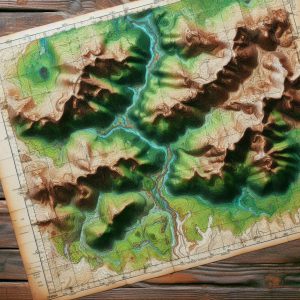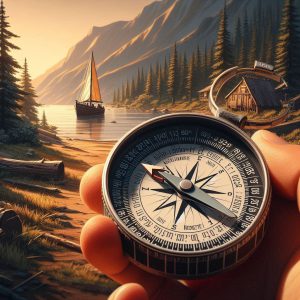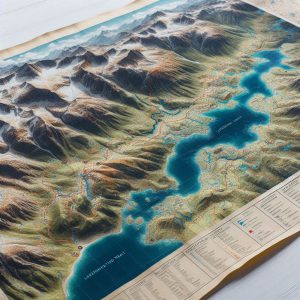Master Essential Wilderness Navigation Skills Without GPS: An Adventurer’s Complete Guide
Becoming proficient in wilderness navigation without modern technology can initially appear challenging, yet developing essential map and compass navigation skills is an incredibly valuable endeavor that significantly boosts your outdoor adventures. At its essence, navigation demands a comprehensive understanding of your surroundings and the capability to accurately determine your position in relation to your intended destination. A map acts as a detailed two-dimensional illustration of the landscape, while a compass offers a reliable method for orienting yourself using the cardinal directions: north, south, east, and west. Mastering these tools empowers you to explore the wilderness confidently and independently, free from the constraints of technology.
Begin your navigation journey by thoroughly familiarizing yourself with the various symbols and scales represented on a map; these components are crucial for effectively interpreting the physical landscape around you. Learning to read contour lines that indicate changes in elevation is vital, as it enables you to identify hills, valleys, and other geographical features that may influence your chosen route. Additionally, becoming adept at compass usage is equally important; it equips you with the ability to navigate successfully in the wilderness without depending on GPS devices, thereby enhancing your self-reliance.
The compass needle always points toward magnetic north, allowing you to align your map with the actual terrain accurately. To achieve this, hold the compass flat in your hand and rotate the map until the magnetic north on the compass aligns with the north indicated on your map. This essential process, known as “orienting the map,” is fundamental to maintaining accuracy in your navigation efforts, ensuring you stay on the correct path and reach your destination efficiently.
Once your map is oriented correctly, you can use the compass to take bearings that will guide your travel direction. By effectively combining these two powerful navigational tools—the map and the compass—you can traverse unfamiliar landscapes confidently, ensuring that you remain on track even without modern technological aids.
Essential Principles for Mastering Outdoor Navigation Techniques
- Gaining proficiency in map and compass navigation is indispensable for anyone engaging in wilderness exploration or various outdoor activities.
- Topographic maps provide intricate details about the terrain, elevation, and natural features, playing a crucial role in successful navigation.
- A compass not only establishes direction but also assists in effective navigation by aligning with the map’s orientation and understanding the concept of magnetic north.
- Utilizing natural landmarks and cues, such as unique rock formations or distinctive tree patterns, can serve as effective navigational aids when a map or compass is unavailable.
- Estimating distance and travel time is essential for planning and executing a successful navigation strategy in the wilderness.
 Grasping the Critical Role of Topographic Maps in Wilderness Navigation
Grasping the Critical Role of Topographic Maps in Wilderness Navigation
Topographic maps are indispensable resources for anyone planning to venture into the wilderness. They provide a wealth of information about the physical characteristics of the terrain, utilizing contour lines to depict changes in elevation. This visual representation allows you to comprehend the shape and steepness of the landscape, which is essential for preparing for the challenges that lie ahead. Each contour line connects points of equal elevation, and the spacing between these lines indicates whether the slope is steep or gradual, equipping you with the necessary knowledge for effective navigation.
How to Understand and Interpret Contour Lines and Map Symbols
As you delve into a topographic map, it is imperative to pay close attention to the arrangements formed by contour lines; tightly packed lines indicate steep terrain, while widely spaced lines signify flatter areas. This understanding empowers you to anticipate potential obstacles along your route, enabling informed navigation decisions. Moreover, topographic maps are filled with symbols that represent various landmarks, such as rivers, roads, trails, and types of vegetation. Familiarizing yourself with these symbols is foundational for successful navigation, ensuring you can utilize the map effectively throughout your adventure.
Techniques for Mastering Navigation with Topographic Maps
For instance, blue lines typically indicate the presence of water bodies, such as streams or lakes, while green areas may signify forests or dense vegetation. By cross-referencing these symbols with your surroundings, you can confirm your location and adjust your route as necessary. Additionally, topographic maps often feature grid lines that assist you in pinpointing coordinates, allowing for even more precise navigation. By mastering the intricacies of topographic maps, you’ll develop a deeper appreciation for the landscape and enhance your overall navigational skills in the wilderness.
 Harnessing Compass Navigation Techniques for Accurate Direction
Harnessing Compass Navigation Techniques for Accurate Direction
An indispensable tool for any adventurer, a compass is vital for directional navigation, especially when traversing unfamiliar landscapes. To use a compass effectively, start by holding it level in front of you and allowing the needle to stabilize. The needle will point toward magnetic north, which can vary slightly from true north due to magnetic declination—the angle between magnetic north and true north shifts based on your geographical location.
Before embarking on your journey, it’s crucial to determine the local declination and adjust your compass accordingly. This adjustment guarantees that your bearings remain accurate, helping you stay on course throughout your adventure. After calibrating your compass for declination, you can proceed to take a bearing that will guide your travel direction effectively.
To take a bearing, identify a landmark you wish to navigate toward and rotate the compass housing until the orienting arrow aligns with the magnetic needle. The degree reading on the compass dial that aligns with the index line indicates your bearing. As you progress toward your destination, periodically check your bearing to ensure that you remain on track, making adjustments as necessary.
If you find yourself veering off course, reorient your compass and adjust your path to stay aligned with your intended route. By mastering these techniques, you will gain the confidence to rely on a compass as a reliable navigational aid in any outdoor adventure.
 Utilizing Natural Landmarks and Clues to Enhance Navigation Efficiency
Utilizing Natural Landmarks and Clues to Enhance Navigation Efficiency
While maps and compasses are essential navigational tools, keenly observing natural landmarks and signs can significantly enhance your ability to navigate the wilderness effectively. Prominent features such as mountains, rivers, or distinctive trees can serve as invaluable reference points when traversing unfamiliar terrain. For example, if you know a specific mountain lies to the east of your starting position, you can use it as a guide to ensure you’re headed in the right direction.
Moreover, familiarizing yourself with the unique characteristics of your surroundings will assist in forming mental maps that empower you to navigate without solely relying on tools. In addition to prominent landmarks, pay attention to natural signs that can indicate direction or changes in terrain. The sun’s position can serve as a helpful guide; in the northern hemisphere, the sun rises in the east and sets in the west, providing a general sense of direction throughout the day.
Additionally, observing moss growth on trees—often denser on the north side—can offer valuable clues about orientation in thick forests. Animal trails can also provide directional hints; many animals follow established paths that can lead you toward water sources or other significant landmarks. By refining your ability to interpret these natural signs, you will become increasingly adept at navigating diverse environments.
Mastering the Art of Estimating Distance and Travel Time for Effective Navigation
Estimating distance and travel time is essential for effective navigation in wilderness areas. Understanding how far you have traveled and how long it will take to reach your destination allows for improved planning and helps prevent unexpected challenges. One practical technique for estimating distance is pacing—counting your steps as you walk.
On average, an adult’s stride measures approximately 2.5 feet, meaning that by counting your steps over a known distance, you can estimate how far you’ve traveled based on your pace. Additionally, consider the type of terrain and elevation changes when calculating travel time. For instance, moving over flat ground typically allows for quicker progress compared to navigating steep hills or rocky paths, which can slow your pace significantly.
A common guideline suggests estimating that you can cover roughly three miles per hour on flat terrain, but this estimate should be adjusted considerably when faced with challenging landscapes. By factoring in these variables and modifying your expectations accordingly, you will be better equipped for your journey and more capable of managing your time effectively.
Creating a Strategic Wilderness Route and Navigation Plan for Success
Charting Your Wilderness Route for Optimal Adventure
Developing an effective navigation plan is crucial before embarking on any wilderness adventure. Begin by studying topographic maps of the area you plan to explore, identifying potential routes based on prominent landmarks, existing trails, and accessible water sources. As you devise your route, consider factors such as elevation changes and the difficulty level of the terrain; ensuring your plan is realistic and achievable is paramount for a successful outing.
Preparing for Unexpected Obstacles and Changes in Your Adventure
While planning your route, it’s wise to consider alternative paths in case you encounter unexpected obstacles or sudden changes in weather. Having multiple options will provide you with greater flexibility during your journey, helping to ensure your safety. This adaptability is crucial for a successful and enjoyable wilderness experience, allowing you to navigate any challenges that may arise with ease.
Formulating a Comprehensive Navigation Strategy for Your Journey
After mapping out potential routes, create a detailed navigation plan that includes critical waypoints. Mark these waypoints on your map and, if possible, note their coordinates, enabling you to track your progress as you navigate through the wilderness. Additionally, factor in estimated travel time between waypoints and identify any potential hazards you might encounter along your chosen route, which can enhance your preparedness.
Ensuring a Safe and Rewarding Outdoor Experience Through Planning
Thorough planning and anticipation of challenges will greatly enhance your chances of reaching your destination while enjoying a safe and fulfilling outdoor experience. A well-structured navigation strategy is vital for a successful wilderness adventure, ensuring that you can explore the great outdoors with confidence and assurance, making the most of every moment.
 Utilizing Emergency Navigation Techniques for Unforeseen Scenarios
Utilizing Emergency Navigation Techniques for Unforeseen Scenarios
Despite meticulous planning and preparation, unforeseen circumstances may arise during outdoor adventures that necessitate emergency navigation techniques. One essential skill is the ability to backtrack; if you find yourself lost or disoriented, retracing your steps can often lead you back to familiar territory. To execute this effectively, pay close attention to distinctive landmarks or features along your route, which can serve as reference points when returning.
Another invaluable technique is celestial navigation, particularly useful when visibility allows—especially during clear nights or sunny days when stars or celestial bodies are visible. Familiarizing yourself with prominent constellations, such as the North Star (Polaris) in the northern hemisphere, can guide you, as it remains relatively fixed in position while other stars shift. By locating Polaris and determining its angle above the horizon, you can ascertain true north, even without a compass or map.
If you have a watch or smartphone as a backup, utilizing it alongside celestial navigation can reinforce your sense of direction during emergencies, helping you maintain your orientation even in challenging situations.
Advancing Your Wilderness Navigation Skills: Practical Tips and Strategies
Enhancing your wilderness navigation skills requires dedication and practice, but the rewards can significantly enrich your outdoor experiences. One effective approach is joining local hiking groups or outdoor clubs, where members can share their knowledge and experiences related to navigation techniques. Engaging with seasoned navigators can offer valuable insights into best practices while providing hands-on learning opportunities across various terrains.
Another beneficial strategy involves regularly practicing with maps and compasses in diverse environments—whether in urban settings or remote wilderness areas—to build your confidence in these skills. Allocate time for solo excursions where you intentionally navigate without technological aids; this method will reinforce your abilities while allowing you to connect more deeply with nature. Furthermore, consider maintaining a navigation journal to document routes taken, challenges encountered, and lessons learned during each adventure; this reflective practice will not only enhance your skills but also deepen your appreciation for navigating diverse landscapes.
By embracing these techniques and continuously refining your skills in map reading, compass usage, natural observation, distance estimation, route planning, emergency strategies, and sharing practical experiences with others, you will evolve into a more self-assured navigator, capable of thriving in any wilderness environment, even without the support of technology.
Your Questions Answered: Comprehensive FAQs About Wilderness Navigation
What does wilderness navigation encompass?
Wilderness navigation includes the skills necessary to determine and maintain a route through natural, often remote, and undeveloped areas. It involves employing various tools and techniques to stay on course and safely reach your desired destination.
What traditional methods are commonly used in wilderness navigation?
Traditional methods of wilderness navigation include utilizing a map and compass, interpreting topographic features, observing natural landmarks, and employing celestial navigation techniques based on the sun, moon, and stars.
Why might someone choose to navigate without GPS technology?
Many individuals opt to navigate without GPS for several reasons, including the desire to enhance their wilderness navigation skills, enjoy the challenge of traditional methods, or prepare for potential GPS failures or limited access to technology.
What benefits arise from mastering wilderness navigation without relying on GPS?
Learning wilderness navigation techniques without GPS can deepen one’s understanding of the natural environment, increase self-reliance and confidence, and provide a backup plan in case of technology failures or limited access to GPS devices.
What challenges may arise when navigating in the wilderness without GPS support?
Challenges associated with wilderness navigation without GPS include the need for advanced planning, the potential for human error, and reliance on environmental conditions such as weather and visibility.
The post Wilderness Navigation Techniques Without GPS appeared first on Survival Bite.
The Article Wilderness Navigation Techniques for Off-Grid Adventures Was Found On https://limitsofstrategy.com



5 Responses
Your exploration of wilderness navigation skills strikes a profound chord with me. In today’s technology-dominated world, it’s easy to overlook the beauty and importance of connecting with our environment through more traditional means. I remember a backpacking trip in the Sierra Nevada a couple of years back when my friend and I decided to unplug entirely—no GPS, just our trusty compass and a detailed topographic map. Initially, we felt a touch of anxiety about navigating without our usual digital crutch, but that quickly transformed into a liberating experience.
Your experience in the Sierra Nevada sounds incredible. There’s something uniquely special about swapping the efficiency of technology for the rawness of nature, isn’t there? That initial anxiety you felt is rather common; stepping away from familiar tools can bring on a wave of uncertainty. I think it’s fascinating how, once you push through that initial discomfort, the rewards of fully engaging with your surroundings can be both enlightening and grounding.
I love how you emphasize the importance of traditional navigation skills! There’s something really grounding about relying on a map and compass—it’s like connecting with the adventurers of the past. I remember a camping trip where my GPS failed, and I had to rely solely on my map-reading skills. It was a bit nerve-wracking, but ultimately super rewarding to find my way.
It’s great to hear you share that experience! There’s something special about turning back the clock and embracing that old-school navigation vibe. It’s like stepping into a history book and channeling your inner Lewis or Clark… or at least trying not to panic while you squint over a map in the pouring rain.
It’s refreshing to see a focus on wilderness navigation skills without reliance on GPS technology. Your post perfectly highlights the wisdom and empowerment that come from mastering map and compass navigation. In my own experience, the first time I attempted to navigate using just these tools, I felt a mix of exhilaration and trepidation. I had always relied on my smartphone, but I decided to challenge myself on a solo hiking trip in the Rockies. It was both daunting and liberating to set out without my usual digital crutch.